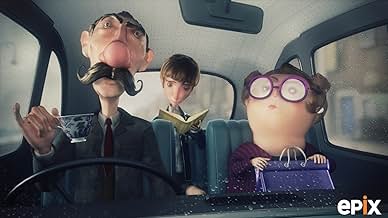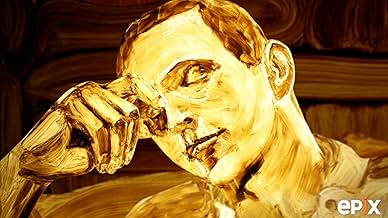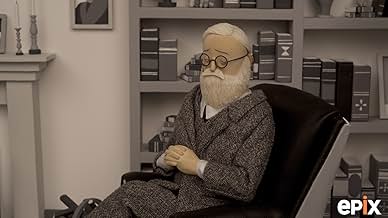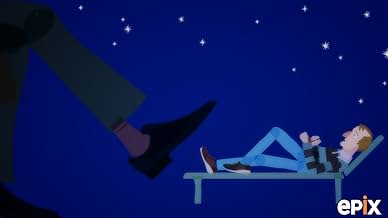AVALIAÇÃO DA IMDb
5,8/10
1,9 mil
SUA AVALIAÇÃO
Adicionar um enredo no seu idiomaAn animated, factually incorrect biography of Graham Arthur Chapman, one of the founding members of the comedy group Monty Python.An animated, factually incorrect biography of Graham Arthur Chapman, one of the founding members of the comedy group Monty Python.An animated, factually incorrect biography of Graham Arthur Chapman, one of the founding members of the comedy group Monty Python.
- Direção
- Roteiristas
- Artistas
Graham Chapman
- Graham Chapman
- (narração)
- …
John Cleese
- John Cleese
- (narração)
- …
Terry Jones
- Terry Jones
- (narração)
- …
Michael Palin
- Michael Palin
- (narração)
- …
Terry Gilliam
- Interview Don #2
- (narração)
- …
Carol Cleveland
- Masseuse
- (narração)
- …
Philip Bulcock
- David Sherlock
- (narração)
Stephen Fry
- Oscar Wilde
- (narração)
Lloyd Kaufman
- Uncle Lloyd
- (narração)
Tom Hollander
- Recording Engineer
- (narração)
Margarita Doyle
- Vomiting Sylvia Krystel
- (narração)
Cameron Diaz
- Seigmund Freud
- (narração)
Ronnie Corbett
- Thompson
- (cenas de arquivo)
- (não creditado)
David Frost
- Self
- (cenas de arquivo)
- (não creditado)
- Direção
- Roteiristas
- Elenco e equipe completos
- Produção, bilheteria e muito mais no IMDbPro
Avaliações em destaque
Was this film put together by several committees? What a disappointing 'tribute' to a great talent! The animation styles were all over the place. Nothing cohesive. It was as if multiple committees of individuals, who never met, had decided to produce different parts of the film without consulting each other. It looks like multiple animation 'artists' were trying to show off their styles of animation without respect to the purpose of the film. What a visual mess! Such a disappointing 'tribute'(?!) to one of the greatest talents in British comedy. It is a disappointing example of 'style over content' A thoroughly disappointing film :-(
I'm a big Monty Python fan but I haven't yet read A Liar's Autobiography (Volume VI).
I was very disappointed with the film as it lacks any of the Monty Python charm. It feels more like a Spike Milligan book, but lacking that crucial, undefinable charm which draws you into a madman's world. It only made me wistful to watch some actual Monty Python. However there is somewhat of a spooky feel in that the film is narrated by Graham Chapman himself, who became an ex parrot in 1989.
The film is mostly animated using multiple styles of animation. Fans of Terry Gilliam animation will be disappointed to see a lack of this style though. There are a number of very crude jokes and references in this film, again lacking the charm to make them truly funny.
The film is somewhat reminiscent of the film Yellow Submarine (1968) and perhaps a sober state of mind is not recommended when watching this film. I highly recommend the Spike Milligan novels as well as any of the Monty Python films or shows.
I was very disappointed with the film as it lacks any of the Monty Python charm. It feels more like a Spike Milligan book, but lacking that crucial, undefinable charm which draws you into a madman's world. It only made me wistful to watch some actual Monty Python. However there is somewhat of a spooky feel in that the film is narrated by Graham Chapman himself, who became an ex parrot in 1989.
The film is mostly animated using multiple styles of animation. Fans of Terry Gilliam animation will be disappointed to see a lack of this style though. There are a number of very crude jokes and references in this film, again lacking the charm to make them truly funny.
The film is somewhat reminiscent of the film Yellow Submarine (1968) and perhaps a sober state of mind is not recommended when watching this film. I highly recommend the Spike Milligan novels as well as any of the Monty Python films or shows.
A Liars Autobiography is a celebration of the life of the elusive and eccentric Graham Chapman. The film is narrated by Chapman himself (he had recorded audio tapes of his memoirs) and the animation alone is a visual feast. It varies in style which suggests that aside from the obvious comedy, the film is much more perceptive and sophisticated than on first glance.
Chapman led a surreal life and was known by the people that knew him as anything but one dimensional. The film depicts just that as well as the reality that perhaps Chapman himself didn't really know who he was. The sequence I most enjoyed was the one depicting Chapman's alcohol withdrawal symptoms, handled with sensitivity and complemented by the eerie & Burton-Esq animation of insects crawling around Chapman whilst he lies in bed, this is a sequence that adds yet another layer to Chapman's identity.
You don't need to be a Monty Python fan to appreciate this film; its sheer brilliance lies in the animation and it's psychedelic depiction of one of the most iconic Pythons. A pleasurable watch, highly recommend.
Chapman led a surreal life and was known by the people that knew him as anything but one dimensional. The film depicts just that as well as the reality that perhaps Chapman himself didn't really know who he was. The sequence I most enjoyed was the one depicting Chapman's alcohol withdrawal symptoms, handled with sensitivity and complemented by the eerie & Burton-Esq animation of insects crawling around Chapman whilst he lies in bed, this is a sequence that adds yet another layer to Chapman's identity.
You don't need to be a Monty Python fan to appreciate this film; its sheer brilliance lies in the animation and it's psychedelic depiction of one of the most iconic Pythons. A pleasurable watch, highly recommend.
Graham Chapman was erratic, flamboyant and, so close friends attest, somewhat unknowable. Before his death in 1989, The comic and Monty Python member completed a bizarre book full of his singular humour, formative experiences recounted in typically skewed fashion, surreal fabrications, and hints towards his struggle with alcohol (he was known to drink several pints of gin daily).
As animation producer Justin Weyers disclosed during the aforementioned workshop, the production team, headed by directors Bill Jones, Jeff Simpson and Ben Timlett, required a certain scope and diverse approach to do justice to the subject matter. What resulted is a patchwork of various animation methods from fourteen different creative teams, helped along the way by vocal contributions from the Pythons, and sewn together with occasional film and interview clips.
The film leaps briskly between animation methods, including cell techniques and stop motion, all converted into stereoscopic 3D. This may sound a jarring and disparate visual style, and it sometimes is. But the piece is helped enormously by the audio narration Chapman recorded of his book, which ties the threads together and drives the whole thing along. There is a clear standout aesthetic, achieved by oil painting every frame onto glass. Wielding rich, textured results, this visual style illustrates the darkest portion of the film, concerning Chapman's attempts to confront his alcoholism. These scenes were so striking it's almost a shame when the section utilising this method drew to a close, other animation styles seeming comparatively flat.
Other highlights arrive in the form of recounted Python meetings in which the comics are for some reason reimagined as monkeys, comically graphic sex scenes, and surreal flights which variously find the comedian wandering around space, and sipping spirits with the Queen. There's an evident attention to craft throughout.
As to be expected from this sort of project, there are sections which don't work as well as others. A stern talking to from a stop motion Sigmund Freud, voiced by Cameron Diaz (who else), is a disappointingly dry episode. On the whole, this is a camp and absurd, sensitively crafted film, at turns irritating, but ceaselessly creative; a fitting tribute to an unpredictable, distinct talent.
www.theframeloop.com
As animation producer Justin Weyers disclosed during the aforementioned workshop, the production team, headed by directors Bill Jones, Jeff Simpson and Ben Timlett, required a certain scope and diverse approach to do justice to the subject matter. What resulted is a patchwork of various animation methods from fourteen different creative teams, helped along the way by vocal contributions from the Pythons, and sewn together with occasional film and interview clips.
The film leaps briskly between animation methods, including cell techniques and stop motion, all converted into stereoscopic 3D. This may sound a jarring and disparate visual style, and it sometimes is. But the piece is helped enormously by the audio narration Chapman recorded of his book, which ties the threads together and drives the whole thing along. There is a clear standout aesthetic, achieved by oil painting every frame onto glass. Wielding rich, textured results, this visual style illustrates the darkest portion of the film, concerning Chapman's attempts to confront his alcoholism. These scenes were so striking it's almost a shame when the section utilising this method drew to a close, other animation styles seeming comparatively flat.
Other highlights arrive in the form of recounted Python meetings in which the comics are for some reason reimagined as monkeys, comically graphic sex scenes, and surreal flights which variously find the comedian wandering around space, and sipping spirits with the Queen. There's an evident attention to craft throughout.
As to be expected from this sort of project, there are sections which don't work as well as others. A stern talking to from a stop motion Sigmund Freud, voiced by Cameron Diaz (who else), is a disappointingly dry episode. On the whole, this is a camp and absurd, sensitively crafted film, at turns irritating, but ceaselessly creative; a fitting tribute to an unpredictable, distinct talent.
www.theframeloop.com
I'm a big fan of the Pythons but before watching this pretty much all I knew about Graham Chapman's life was that he was an alcoholic and gay. Sadly, after watching the film, that still seems to be pretty much all there was to him.
A series of animation teams take us through Chapman's life from birth to death and with varying degrees of success, all with Chapman's narration. The visuals are mostly good and help to keep interest but anyone looking for insight will be disappointed. A self-indulgent sequence about Chapman's drinking withdrawal covers well-trodden ground and the repeated jokes about penises and ejaculation soon wear thin. OK, he was gay - we get it! The directors make the mistake of trying to be Pythonesque but nearly all the gags fall flat, while the storytelling gets lost and the timeline muddled. Chapman was a great performer and writer, but you wouldn't know it from this, which moves his art largely to 3rd place behind alcohol and being gay. A writing trip with Cleese seems happy to say Cleese did all the hard work on their projects while the sort of roles that gave Chapman the Hollywood lifestyle are brushed over.
Perhaps a better approach would have been to include archive footage and new materials, to explain things and provide context and perspective. Ultimately, this is just an unsatisfying film from some well-meaning Python fanboys.
A series of animation teams take us through Chapman's life from birth to death and with varying degrees of success, all with Chapman's narration. The visuals are mostly good and help to keep interest but anyone looking for insight will be disappointed. A self-indulgent sequence about Chapman's drinking withdrawal covers well-trodden ground and the repeated jokes about penises and ejaculation soon wear thin. OK, he was gay - we get it! The directors make the mistake of trying to be Pythonesque but nearly all the gags fall flat, while the storytelling gets lost and the timeline muddled. Chapman was a great performer and writer, but you wouldn't know it from this, which moves his art largely to 3rd place behind alcohol and being gay. A writing trip with Cleese seems happy to say Cleese did all the hard work on their projects while the sort of roles that gave Chapman the Hollywood lifestyle are brushed over.
Perhaps a better approach would have been to include archive footage and new materials, to explain things and provide context and perspective. Ultimately, this is just an unsatisfying film from some well-meaning Python fanboys.
Você sabia?
- CuriosidadesThe audio under the opening credits is from a sketch Chapman regularly used to perform, where he asked a live audience at the start of the show to give him "thirty seconds of abuse", as this saved time later on. For this movie, specially recorded abuse was added from John Cleese, Sir Michael Palin, Terry Jones (shouting Medieval curse words), Terry Gilliam, Carol Cleveland, and David Sherlock, Chapman's former partner. One of the investors in this movie can also be heard shouting "I want my f**king money back!"
- Erros de gravaçãoSigmund Freud's name is misspelled as "Seigmund Freud" in the opening title sequence and closing credits.
- ConexõesFeatured in De wereld draait door: Episode #8.126 (2013)
- Trilhas sonoras633 Squadron
Written by Ron Goodwin
(P) EMI Partnership Ltd
Performed by Central Band of the Royal Air Force (as The Central Band of the RAF) with Principle Director of Music Wing Commander H. B. Hingley MBE
Produced by Roberto Danova
Supplied by kind permission of PLAZA Records Ltd
Principais escolhas
Faça login para avaliar e ver a lista de recomendações personalizadas
Detalhes
- Data de lançamento
- País de origem
- Centrais de atendimento oficiais
- Idioma
- Também conhecido como
- Graham Chapman: Dead in 3-D
- Empresas de produção
- Consulte mais créditos da empresa na IMDbPro
Bilheteria
- Faturamento bruto nos EUA e Canadá
- US$ 5.102
- Fim de semana de estreia nos EUA e Canadá
- US$ 5.102
- 4 de nov. de 2012
- Faturamento bruto mundial
- US$ 63.469
- Tempo de duração
- 1 h 25 min(85 min)
- Cor
- Proporção
- 1.85 : 1
Contribua para esta página
Sugerir uma alteração ou adicionar conteúdo ausente





































